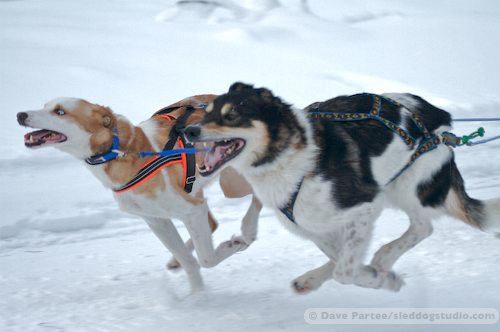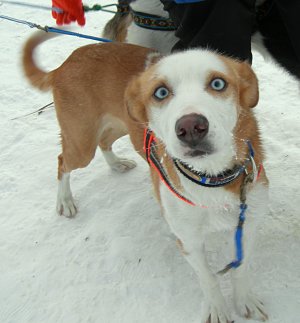
piper taking a nap, tok 2006
This weekend's race was the final challenge race of the season. Andrea and the dogs finished the 5.9 mile course in under 20 minutes for the first time ever, which was good enough for fourth place. She was very happy with the dogs and their performance.
The photo on the right shows Piper sleeping with her head on the steering wheel down in Tok. It's a two day race at the end of the season, and the dogs (and us!) get very tired by the end.

milling whole wheat flour
Over the past few years I've been working on trying to lower the amount of processed, "industrial" food in my diet. I don't agree with all of Michel Pollan's arguments in his recent New York Times Magazine article (Unhappy meals), but I do think he's right that we'd be a much healthier society if processed foods didn't supply the majority of our calories. We might be getting all of the named nutrients through industrial fortification of nutrient-poor refined foods, but it makes sense to wonder if it wouldn't be better to be eating the unprocessed food that has all the nutrients (both named an unnamed) already built in.
Last week I got a grain mill, bought several sacks of organically grown whole grains (hard red spring wheat, rye, and oat groats; yellow corn on the way) and have been working them into my diet. Steel cut oats with a little rye and wheat cooked into porridge for breakfast, and whole flours baked into bread for lunch.
Why mill my own? Turns out that the oils in most whole grains spoil rapidly after milling (which is one reason why refined grains have become so popular with producers and retailers, and why refined food has to be fortified with nutrients lost during processing), so the whole flours, corn meal, and other grains you buy in the supermarket have probably already started getting rancid. Corn is especially prone to this because, according to The Laurel's Kitchen Bread Book, corn has been selectively bread to maximize oil production in the seed, which contributes to a much shorter shelf life when the whole grain is milled. Whole grains will last years if they don't get wet or infested with bugs. I can also get organically grown whole grains, and that's not always a choice at the supermarket.
I got a Family Grain Mill, which is an inexpensive, but efficient mill. It's mostly plastic, which means it probably won't last forever, but it does a nice job at milling grains to any size from practically whole all the way down to flour. Milling grain into flour takes two passes, one from whole grain to grits size (which raised the temperature of my grain from 59°F to 73°F) and a second pass to flour (raising the final flour to 84°F, which is perfect for forming a warm dough that the yeast can groove on).
Yesterday I baked my first 100% whole wheat bread using grain I milled into flour that same day. I didn't have any trouble getting a nice elastic dough, and the bread turned out nicely.

photo © 2007 Dave Partee
It was a warm 21°F when the race started, but Andrea and the dogs kept up the pace and came in third place again! The fourth place finisher was only 6 seconds behind over 5.9 miles. Their time was 20:48.3 for an average speed of 17.0 miles per hour.
Our friend Dave took the photo on the right of Piper and Buddy leading the team. It looks like Buddy is completely off the ground in the photo.
For more information about dog mushing here in Fairbanks, check out Andrea's feature story from the University of Alaska Fairbanks home page.

photo © 2007 Michel dos Santos Mesquita
Andrea and the dogs placed third out of twelve teams in the third ADMA challenge race of the season. At one of the turns, Buddy listened to Andrea and started to make the turn but Piper (pictured on the right) decided to ignore her, and Buddy followed along. Down went the snow fence blocking the trail, as well as Andrea and the sled. Despite that, they still had their second best time over the 4.5 mile trail.
Thanks to Michel for the great photo of Piper after the race!
Every so often I get curious about nutrition and whether my diet is actually a healthy one. Over the years I've used a program called NUT, which is a really great console program that uses all the data from the USDA National Nutrient Database for Standard Reference. A couple days ago I downloaded the latest version and compiled it on my MacBook Pro. Thanks to the genius of writing simple, portable C code that builds with gcc, it compiled perfectly (not even a single warning) and I was off and running.
Unfortunately I was having a little trouble deleting the 26,642 gram (58+ pound) apple I accidentally entered for lunch today, and because I had the source code available, I discovered a buffer overflow error in the menu entry code. (A buffer overflow is sort of like when a form asks for your first name but only has room for six letters, and instead of stopping at C-h-r-i-s-t you continue to write the rest of your name into the following boxes not designed for your first name.) So I wrote to the author. An hour later, he wrote me back to thank me for finding the bug. Along the way he found a couple more, fixed them, and released a new version.
Timeline: Find a bug before dinner. Contact author. By the time I'm having my first beer, the program has already been fixed.
Try getting that kind of support from your commercial vendor.